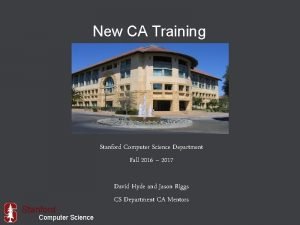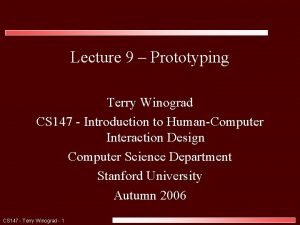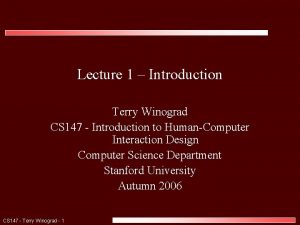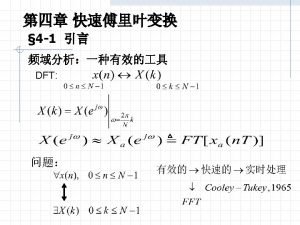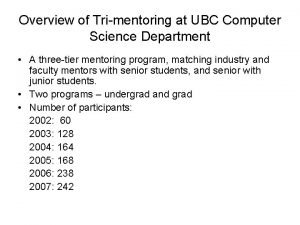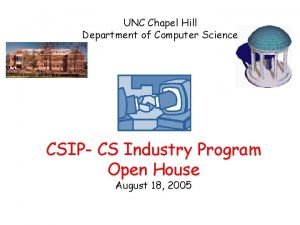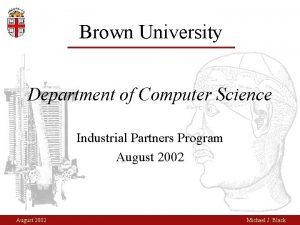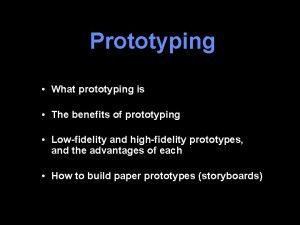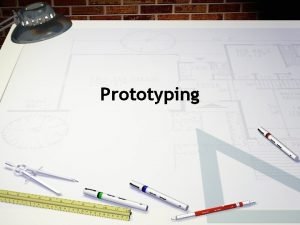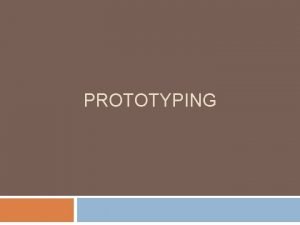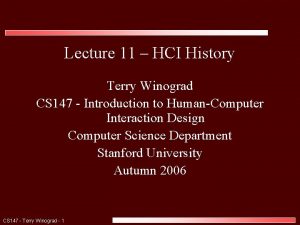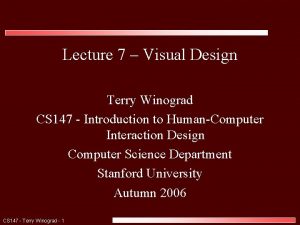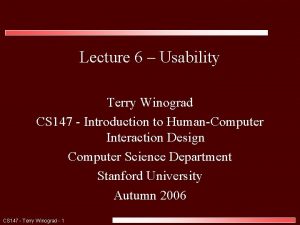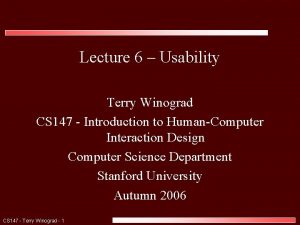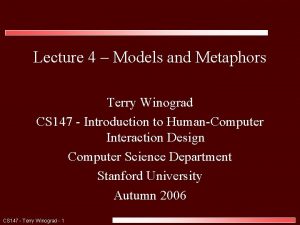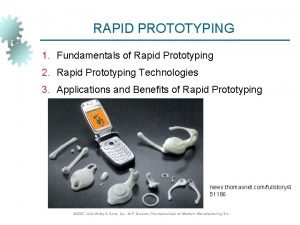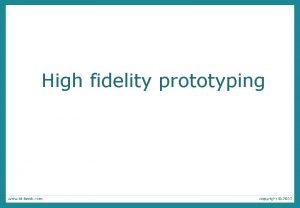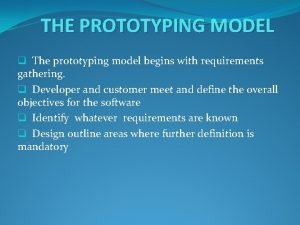Prototyping Terry Winograd Computer Science Department Stanford University
































- Slides: 32

Prototyping Terry Winograd Computer Science Department Stanford University

Learning Goals • Understand the uses of different types of prototypes for different kinds of designs and be able to choose appropriately • Know the basic techniques for lowfidelity prototyping • Be able to determine and apply the relevant techniques for your project

What is a Prototype? • A representation of a design before the final artifacts exist • To evoke reactions from stakeholders in the design process – Designers – Users – Clients

Uses of Prototypes • Design by doing – Clarify goals and requirements – “Reflective conversation with the materials” • Give users the experience of use – Look and feel • Test specific aspects – Compare alternatives – Make changes • Show feasibility for buy-in – Proof of concept – Manage expectations

What to Prototype? “…Prototypes provide the means for examining design problems and evaluating solutions. Selecting the focus of a prototype is the art of identifying the most important open design questions. ” Houde and Hill – What do Prototypes Prototype?

Design Process UNDERSTAND OBSERVE IMPLEMENT VISUALIZE EVALUATE PROTOTYPE

Iterative Prototyping • Quality is a function of the number of iterations and refinements a design undergoes before it hits the street. • To get a good idea, get lots of ideas. • Enlightened trial and error is better than the planning of a flawless intellect.

FAIL EARLY (Cost of failure vs. project time curve) From Hans Haenlein, IDEO

FAIL OFTEN (Risk vs. iteration curve) From Hans Haenlein, IDEO

3 stages of prototyping # of ideas INSPIRE EVOLVE VALIDATE project time LOW prototype RESOLUTION driven specs → spec HIGH driven RESOLUTION prototypes From Hans Haenlein, IDEO

Designing the Prototype • Choose what aspects to prototype for relevance to your project goals • Identify measurable design goals • Good enough to provide feedback but flexible enough for significant changes to be made down the line

What can be a Prototype? • • • Sketches Diagrams & Frameworks Hand Made Constructions Machined Constructions Virtual Models Graphics Packaging Spaces Role Play, Experiences Video …


Prototypes • Look like… • Work like… • Experience like …. .

PROTOTYPE RAPID (IDEO “surgical tool”)

PROTOTYPE ROUGH

Experience Prototyping Jane Fulton Suri - IDEO

From Greenbaum and Kyng, Design at Work 1991

Early Stage Prototypes • Low Fidelity (Paper) – Work with artifacts • Skits / Informance – Understand roles and context Focus on concepts, not detail Low investment in status quo Openness to change

Paper Prototype http: //www. mindspring. com/~bryce_g/projects/lo_fi. html

Low-Fidelity Prototype http: //bmrc. berkeley. edu/courseware/cs 160/fall 99/projects/t 4/body/low-fi/



Flipbook

Flipbook

Flow Diagrams From a previous cs 147 project…

Be Clever About Faking It • Device Mockups – Palm, Utopia, . . • Device substitution – PC prototype for small device – Tethers for wireless – Pager for defibrillator –… • Wizard of Oz techniques

Wizard of Oz • Some aspects of interface are implemented • Operation requires processing that is actually done by a human, not directly visible to the user • The “wizard” intervention needs to be designed to be believable, both technologically and to the user

Fidelity is a Spectrum • Medium fidelity – Cleaned up but not decorated – Wireframes, Blocks, Greeking, …

Medium Fidelity Prototypes


Breadth vs. Depth • Horizontal Prototype – Top level – Basic features • Vertical Prototype – Path in depth – Clickthrough or interactive • Combinations
 Meredith hutchin stanford
Meredith hutchin stanford Computer science department columbia
Computer science department columbia Stanford university philosophy department
Stanford university philosophy department Winograd
Winograd Winograd
Winograd Winograd schema
Winograd schema Winograd fft
Winograd fft Winograd
Winograd Winograd schema
Winograd schema Winograd schema
Winograd schema Computer science ucl
Computer science ucl Electrical engineering northwestern
Electrical engineering northwestern Computer science department rutgers
Computer science department rutgers Florida state university cs faculty
Florida state university cs faculty Trimentoring
Trimentoring Bhargavi goswami
Bhargavi goswami What's your favourite lesson?
What's your favourite lesson? University of phoenix computer science
University of phoenix computer science University of bridgeport engineering
University of bridgeport engineering University of bridgeport computer engineering
University of bridgeport computer engineering Yonsei university computer science
Yonsei university computer science York university computer science
York university computer science Unc ch computer science
Unc ch computer science Seoul national university computer science
Seoul national university computer science Osaka university computer science
Osaka university computer science Computer science columbia university
Computer science columbia university Towson university computer science
Towson university computer science K-state computer science
K-state computer science Brown university computer science
Brown university computer science Trinity university computer science
Trinity university computer science Brandeis university computer science
Brandeis university computer science Institute of computer science university of tartu
Institute of computer science university of tartu Kotebe metropolitan university computer science
Kotebe metropolitan university computer science
